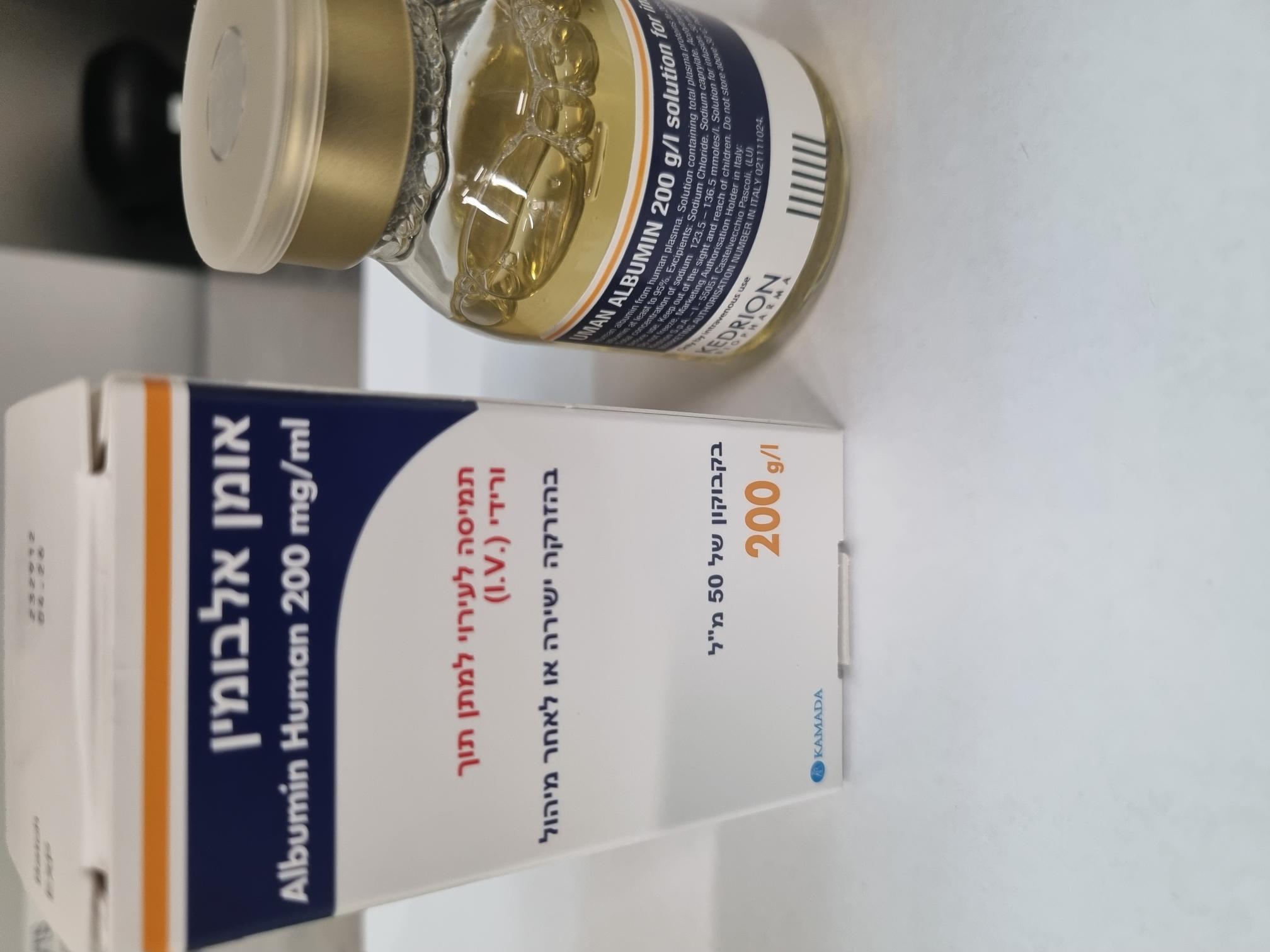Quest for the right Drug

אומן אלבומין UMAN ALBUMIN (ALBUMIN HUMAN)
תרופה במרשם
תרופה בסל
נרקוטיקה
ציטוטוקסיקה
צורת מתן:
תוך-ורידי : I.V
צורת מינון:
תמיסה לאינפוזיה : SOLUTION FOR INFUSION
עלון לרופא
מינוניםPosology התוויות
Indications תופעות לוואי
Adverse reactions התוויות נגד
Contraindications אינטראקציות
Interactions מינון יתר
Overdose הריון/הנקה
Pregnancy & Lactation אוכלוסיות מיוחדות
Special populations תכונות פרמקולוגיות
Pharmacological properties מידע רוקחי
Pharmaceutical particulars אזהרת שימוש
Special Warning עלון לרופא
Physicians Leaflet
Special Warning : אזהרת שימוש
4.4 Special warnings and precautions for use Traceability In order to improve the traceability of biological medicinal products, the name and the batch number of the administered product should be clearly recorded. Suspicion of allergic or anaphylactic type reactions requires immediate discontinuation of the infusion. In case of shock, standard medical treatment for shock should be implemented. Albumin should be used with caution in conditions where hypervolaemia and its consequences or haemodilution could represent a special risk for the patient. Examples of such conditions are: − decompensated cardiac insufficiency − hypertension − oesophageal varices − pulmonary oedema − haemorrhagic diathesis − severe anaemia − renal and post-renal anuria The colloid-osmotic effect of human albumin 200 is approximately four times that of plasma. Therefore, when concentrated albumin is administered, care must be taken to assure adequate hydration of the patient. Patients should be monitored carefully to guard against circulatory overload and hyperhydration. 200 g/l human albumin solutions are relatively low in electrolytes compared to the 40- 50 g/l human albumin solutions. When albumin is given, the electrolyte status of the patient must be monitored (see section 4.2) and appropriate steps taken to restore or maintain the electrolyte balance. Albumin solutions must not be diluted with water for injections as this may cause haemolysis in recipients. If comparatively large volumes are to be replaced, controls of coagulation and haematocrit are necessary. Care must be taken to ensure adequate substitution of other blood constituents (coagulation factors, electrolytes, platelets and erythrocytes). If the haematocrit drops below 30%, packed red cells must be given in order to maintain the oxygen transport capacity of the blood. Hypervolaemia may occur if the dosage and rate of infusion are not adjusted to the patient’s circulatory situation. At the first clinical signs of cardiovascular overload (headache, dyspnoea, jugular vein congestion), or increased blood pressure, raised venous pressure and pulmonary oedema, the infusion is to be stopped immediately. Important information about excipients of UMAN ALBUMIN This medicinal product contains up to 157 mg sodium per vial of 50 ml and 314 mg per vial of 100 ml, equivalent to 7.85 % (for vial of 50 ml) and 15.7 % (for vial of 100 ml) of the WHO recommended maximum daily intake of 2 g sodium for an adult. Viral safety Standard measures to prevent infections resulting from the use of medicinal products prepared from human blood or plasma include selection of donors, screening of individual donations and plasma pools for specific markers of infection and the inclusion of effective manufacturing steps for the inactivation/removal of viruses. Despite this, when medicinal products prepared from human blood or plasma are administered, the possibility of transmitting infective agents cannot be totally excluded. This also applies to unknown or emerging viruses and other pathogens. There are no reports of virus transmissions with albumin manufactured to European Pharmacopoeia specifications by established processes. Paediatric population Although no specific data are available for paediatric population, the clinical experience on the use of Human Albumin in children suggests that no differences between adults and children are to be expected, provided that a careful attention to the dosage has been observed in order to avoid circulatory overload.
Effects on Driving
4.7 Effects on ability to drive and use machines UMAN ALBUMIN has no or negligible influence on ability to drive and use machines.

שימוש לפי פנקס קופ''ח כללית 1994
לא צוין
תאריך הכללה מקורי בסל
01/01/1995
הגבלות
תרופה מוגבלת לשימוש בבתי חולים או אשפוז יום
מידע נוסף
